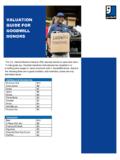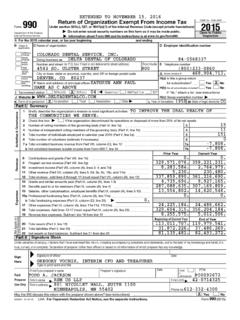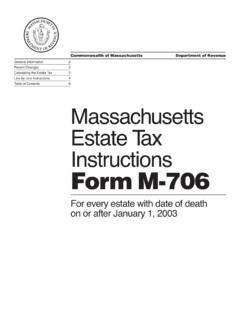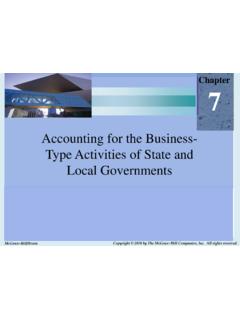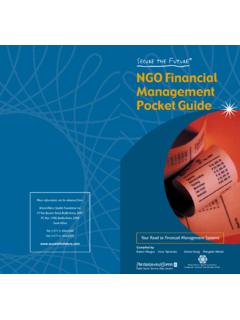Transcription of E. DEDUCTIONS OF CONTRIBUTIONS TO IRC …
1 1985 EO CPE Text E. DEDUCTIONS OF CONTRIBUTIONS TO IRC 501(c)(3). ORGANIZATIONS. AND OTHER EXEMPT ORGANIZATIONS. 1. Introduction - Charitable CONTRIBUTIONS A. Itemizing DEDUCTIONS Charitable CONTRIBUTIONS to qualified organizations are deductible by individuals and corporations. Partnership CONTRIBUTIONS are passed through to the partners under IRC 703(a). Formerly, individuals had to itemize their DEDUCTIONS to take advantage of charitable CONTRIBUTIONS . However, for tax years beginning in 1982 through 1986 individuals who do not itemize their DEDUCTIONS will be permitted to deduct a portion of their charitable CONTRIBUTIONS directly from gross income. The portion deductible is a percentage of the amount allowable. For 1982. and 1983 the maximum deduction is 25 percent of the first $100 ($50 if married filing separately); in 1984 it is 25 percent of the first $300 ($150 if married filing separately); for 1985 the deduction is 50 percent of the amount allowable, and for 1986 it is 100 percent of the amount allowable.
2 This special deduction for nonitemizers shall not apply to CONTRIBUTIONS made after December 31, 1986. IRC. 170(i)(4). B. Qualifying Organizations A charitable contribution is defined in IRC 170(c)(1) as a contribution or gift to or for the use of a state, a possession of the United States, or any political subdivision of any of the foregoing, or the United States or the District of Columbia, made exclusively for public purposes, and in IRC 170(c)(2) as a contribution or gift to domestic organizations described in IRC 501(c)(3) except those organized and operated for testing for public safety. CONTRIBUTIONS to IRC. 501(c)(1) organizations, corporations organized under Acts of Congress that are instrumentalities of the United States, are deductible under IRC 170(c)(1). CONTRIBUTIONS to IRC 501(c)(4) organizations are deductible under IRC 170(c)(1) if made to the organization for the use of a state, a possession of the United States, or any political subdivision of the foregoing, the United States, or the District of Columbia, if the CONTRIBUTIONS are made exclusively for public purposes.
3 Rev. Rul. 71-47 holds that CONTRIBUTIONS to a volunteer fire company that qualifies for IRC. 501(c)(4) exemption are deductible under IRC 170(c)(1) because they are deemed to be for the use of a political subdivision of a state for exclusively public purposes. Certain volunteer fire companies have been held to qualify for IRC. 501(c)(3) exemption because they have a charitable purpose and lessen the burdens of government. See Rev. Rul. 74-361, 1974-2 159, clarifying Rev. Rul. 71-47, 1971-1 92. Also, CONTRIBUTIONS are deductible as charitable CONTRIBUTIONS when paid to a civil defense organization created under federal, state, or local law. Such CONTRIBUTIONS include unreimbursed expenses of civil defense volunteers that are directly connected with and solely attributable to their volunteer help. News Release No. 372, March 27, 1961. CONTRIBUTIONS to needy individuals are not deductible because individuals are not qualifying organizations under IRC 170.
4 Even though it has been determined that a payment has been made to a qualifying organization, if the amount is earmarked, further investigation may be appropriate to determine whether the payment constitutes a deductible contribution. In Thomason v. Commissioner, 2 441 (1943), the court held that amounts paid to provide special advantages for a particular child in an orphanage were not deductible when earmarked for that child. C. Limitation on Charitable DEDUCTIONS Depending on the donee organization, an individual's deduction for charitable CONTRIBUTIONS is limited to 50 percent or 30 percent of the taxpayer's contribution base. Prior to the Deficit Reduction Act of 1984 ( 98-369), the 30. percent figure was 20 percent. An individual's contribution base is the adjusted gross income computed without regard to any net operating loss carryback. Organizations subject to the 50 percent limitation for individuals are those described in IRC 170(b)(1)(A)(i) through (viii), which include churches, schools, hospitals, university endowment foundations, publicly supported organizations, and governmental units.
5 Other organizations subject to this limitation are IRC. 509(a)(2) and (3) organizations, private operating foundations, and private nonoperating foundations described in IRC 170(b)(1)(E)(ii) and (iii). The 50. percent limitation also applies to cooperative hospital service organizations and cooperative service organizations of operating educational organizations described in IRC 501(e) and (f). The 30 percent limitation on the contribution deduction applies to IRC. 501(c)(3) private foundations except those described above, and all IRC 170(c). organizations other than IRC 170(c)(1) and 170(c)(2). D. The Timing of Charitable DEDUCTIONS A contribution must be made in cash or property before the close of the tax year in order for it to be deductible in that year. This applies whether the cash or the accrual method of accounting is used. For example, if a taxpayer pledges $3,000 to a church on October 30, 1985, to be paid by October 30, 1986, the taxpayer may deduct in 1985 only the amount he or she actually pays by December 31, 1985.
6 A contribution charged on a bank credit card is deductible as a charitable contribution under IRC 170(a) in the year the charge is made regardless of when the bank is paid. See Rev. Rul. 78-38, 1978-1 67. 2. Definition of Charitable Contribution To be deductible as a charitable contribution under IRC 170, a payment to or for the use of a qualified charitable organization must be a gift. In order for a gift to exist, there must be, among other requirements, a payment of money or transfer of property without adequate consideration. Under IRC 170, if the donor receives something of value for a payment, all or part of the payment will not be a gift and a deduction in whole or in part will not be allowed. Further, if the payment is a gift, but is not made for charitable purposes, a deduction for the payment will be disallowed. A. Something of Value Received for a Contribution When something of value has been received by a donor, there is a presumption that there has been no gift and the burden is on the donor to establish that the amount paid is not the purchase price of the item, privilege, or benefit received and that part of the payment, in fact, does qualify as a gift.
7 To establish that, an essential element of proof is that the portion of the payment claimed as a gift represents the excess of the total amount paid over the value of the consideration received. That may be established by evidence that the payment exceeds the fair market value of the privilege or other benefit received by the amount claimed to have been paid as a gift. See Rev. Rul. 67-246, 1967-2 104. When a fundraising event is designed to solicit payments that are intended to be in part the purchase of admission to an event or some other participation in an event, the organization conducting the activity should use procedures that clearly indicate how much of the payments is a gift. This requires a determination by the organization of the amount attributable to the purchase of admission or other privileges and the amount solicited as a gift. The respective amounts should be stated at the time of the solicitation and indicated on the ticket, receipt, or other evidence issued in connection with the payment.
8 Examples of these requirements are given in Rev. Rul. 67-246. A member of a qualified organization who pays membership dues or fees to the organization may also receive a benefit or privilege for the payment which must be taken into consideration in determining what amount, if any, of the fee or dues payment is deductible. B. Donations of Property A donation of property, whether it is used clothing or furniture or something of greater value such as jewelry, paintings, etc., may be deducted only at its fair market value at the time of the gift, with certain reductions provided in IRC 170(e). The fair market value is the price at which the property would change hands between a willing buyer and a willing seller, neither being under any compulsion to buy or sell and both having reasonable knowledge of relevant facts. The cost of the property or the actual selling price may be the best indication of its fair market value.
9 However, because conditions in the market change, the cost or selling price of the property may have less weight if the property were not bought or sold reasonably close to the date of contribution (valuation date). The actual date the contribution was made is important because the value of the donated property must be determined as of that date, and generally the value of the property on that date must be used to arrive at the amount of the contribution. Jewelry, gems, paintings, antiques, and other art objects of considerable value should be supported by a written appraisal from a qualified and reputable source. The weight to be accorded any appraisal made either at or after the valuation date depends largely upon the competence and knowledge of the appraiser with respect to the property and the market for such property. See Publication 561, Determining the Value of Donated Property, and Rev. Proc. 66-49, 1966-2 1257.
10 Section 155 of the Deficit Reduction Act of 1984 requires a qualified appraisal for certain CONTRIBUTIONS of property made after December 31, 1984. See page 25 of this text. C. Out-of-Pocket Expenses Unreimbursed out-of-pocket expenses paid in rendering services without compensation to a qualified donee are deductible as a contribution and, if the donee is an IRC 170(b)(1)(A) organization, they are subject to the 50 percent limitation. Rev. Rul. 84-61, 1984-17 8. These expenses include amounts paid for transportation from the taxpayer's residence to the place of service. Reasonable payments for necessary meals and lodging while away from home donating services may also qualify. Although out-of-pocket automobile expenses for gas, oil, and repairs are deductible, a taxpayer may not deduct a pro-rata portion of general repair and maintenance expenses. A deduction of 9 cents per mile (12. cents after December 31, 1984) may be claimed as a contribution in place of the actual expenses.










